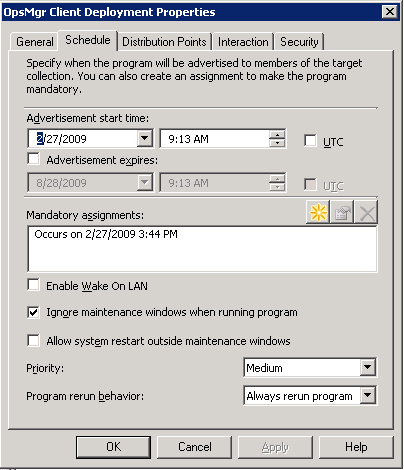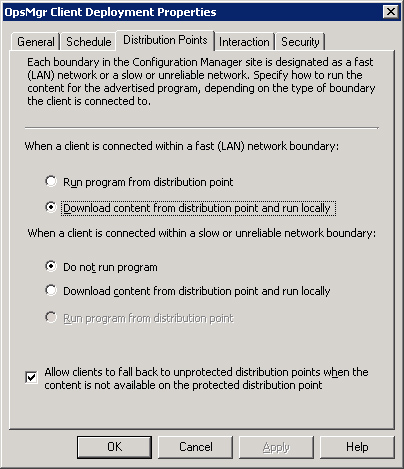2.2 Advertisement Schedule
The
advertisement Schedule tab provides each of the configurations shown
when creating the advertisement with the Distribute Software to
Collection Wizard. These include when an advertisement is scheduled to
start, whether it is assigned as mandatory, whether it should use Wake
On LAN, whether to ignore maintenance windows when running programs,
and whether to allow system restarts outside of maintenance windows.
This tab also allows you to change either the priority or the program rerun behavior, as shown in Figure 9.

Priority— This includes the following options:
Medium (default)— This setting is effective for most situations.
Low— This setting is useful when the advertisement is not particularly time critical.
High— This setting is useful when the advertisement is really time critical.
Program rerun behavior—
Program rerun behavior includes the options to never rerun an
advertised program, to always rerun the program (the default
configuration), to rerun if the previous attempt failed, and to rerun
if the previous attempt succeeded. This setting only has an impact on
an advertisement if it is assigned, because users can run optional programs at any time and ConfigMgr does not restrict a program from rerunning.
2.3 Advertisement Distribution Points
The
advertisement Distribution Points tab shows the configuration decided
upon in the Distribute Software to Collection Wizard, which is the
option to run the program from a distribution point or to download the
content from a distribution point and run it locally.
When a client is connected within a slow or unreliable network boundary— Three options are available for how a client will respond when connected on a slow or unreliable network boundary:
To not run the program. (The default configuration is shown in Figure 10.)

To download content from a distribution point and run it locally.
To
run a program from the distribution point. (This option is unavailable
and grayed out when a client is connected within a slow or unreliable
network boundary.)
Allow
clients to fall back to unprotected distribution points when the
content is not available on the protected distribution point— By
default, this option is checked. When checked, this specifies the
client should fall back to an unprotected distribution point if the
content is not available on the protected distribution point.
Downloading content from the distribution point and running it locally
is useful when BITS is enabled on the distribution point, because the
client can download all the content regardless of the network speed or
reliability. If your environment is limited to only protected
distribution points, this option is not beneficial—the client will not
fail over to anything because there is nothing that is unprotected to
allow the failover.